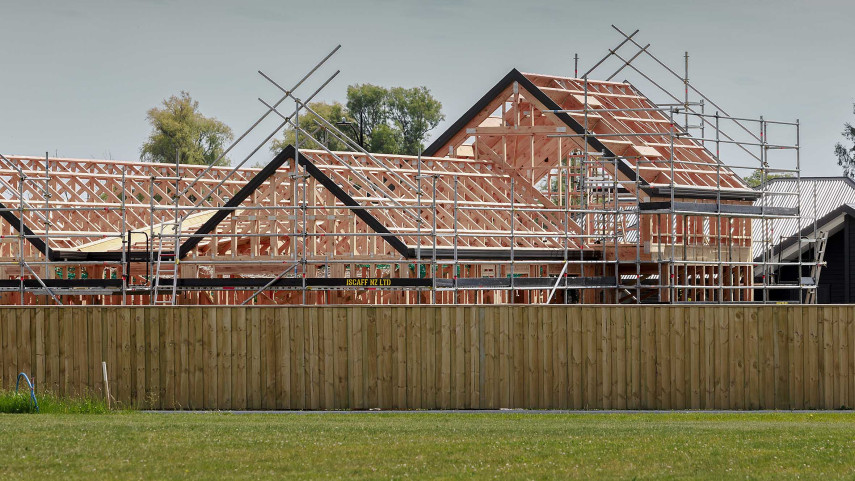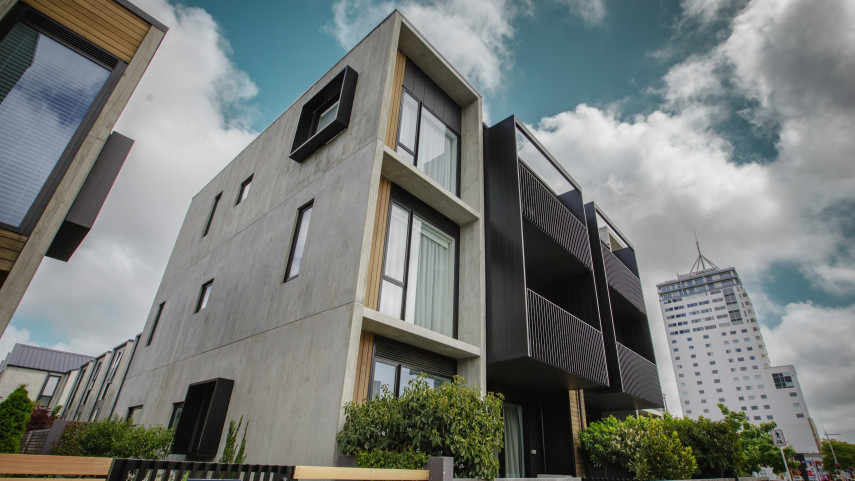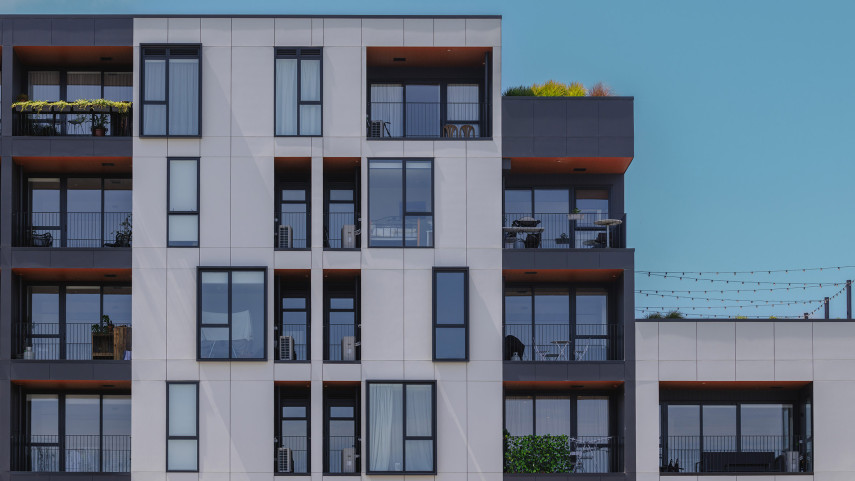Various building work may require building consent, discretionary exemption and/or resource consent.
Guidance for obtaining building consent if your project includes a single stand-alone dwelling or an accessory building such as a garage, carport, gazebo, shed, deck or retaining wall.
Most types of building work require building consent(external link), however, there are some types of building work that is considered low-risk and are exempt(external link) from requiring a building consent.
Eco Design Advisors (external link)provide free, independent, expert advice on new home design and renovation. Advice is available for homeowners, home designers, builders and industry professionals.
You will need to complete the application form online, or if by post or in person, complete the application for building consent and/or Project Information Memorandum (Form 2) - Form B-002 [DOCX, 438 KB] (also available as a PDF [PDF, 378 KB]).
Include the single residential dwelling and accessory building application checksheet - Form B-062 [DOCX, 102 KB] (also available as a PDF [PDF, 80 KB]) in your application.
Further information
- Guide to applying for a building consent (residential buildings)(external link) - Examples of sample drawings.
- Water connection application - Form WS1 [PDF, 1.6 MB]
- Stormwater disposal tests - Form B-091 [PDF, 17 KB]
- Potable water supply - Information sheet B-313 [PDF, 23 KB]
- Domestic fire sprinkler - Information sheet B-314 [PDF, 25 KB]
- Controlling sediment run-off from building sites - Information sheet B-332 [PDF, 168 KB]
- Building on small sites booklet [PDF, 4.9 MB]
- Vehicle crossing application(external link)
You must obtain building consent(external link) to install or move a solid or liquid fuel space heater in your building. You do not need building consent to just replace a flue or firebricks with comparable materials but your work will still need to comply with the building code.
Installing a heat pump does not require building consent but must be installed by registered electricians who certify their own work.
Check Environment Canterbury's (ECan) list of authorised solid fuel burners. The Council has checked and approved the installation instructions for most burners shown on the list of authorised appliances(external link).
Note
The rules around which solid fuel burner you can install have changed when within a clean air zone and in a site less than two hectares. From 1 January 2019, any new burner installed must be an ultra-low emission burner.
An older-style wood burner is not permitted for use, regardless of its age. It can be replaced by an ultra-low emission burner. Contact Environment Canterbury on 0800 324 636 (0800 ECINFO) if you are unsure about what type of burner you have, or if you are worried about your home heating situation.
Second-hand solid and liquid fuel burners cannot be installed unless:
- A current Clean Air approval label is attached to the appliance. This is not applicable to some minor rural areas of Christchurch.
- Written evidence is provided to show that the appliance meets building code requirements. An acceptable method is a satisfactory report from the manufacturer or manufacturer’s agent.
A new inner flue is required in all cases.
Heating systems that require building consent also include:
- Any system using reticulated water, like under-floor heaters or radiators where these are connected to the drinking water supply.
- All commercial heating and ventilation systems.
Heaters that do not require building consent are:
- Gas heaters (permanently fixed in place) do not need building consent, but they must be installed or supervised by a certifying gas fitter who will certify their own work.
- Fixed electric space heaters, including heat pumps, do not require building consent, but they must be installed by registered electricians who certify their own work.
You will need to complete the application form online, or if by post or in person, complete the application for building consent and/or project information memorandum (Form 2) - Form B002 [DOCX, 438 KB] ( also available as a PDF [PDF, 378 KB] ).
Refer to the B-308 applying for a building consent to install a solid fuel burning appliance (residential only) [DOCX, 889 KB] for further guidance on the details we require you to provide when applying.
Further information
Clause 38, Schedule 1, Building Act 2004 allows a person authorised under the Plumbers, Gasfitters, and Drainlayers Act 2006 to install a solar water heating system if that system is a controlled heat source so long as the hot water cylinder is being replaced or repositioned.
For further information, read the MBIE’s guidance on building work that does not require building consent(external link).
The Council will consider an application for a discretionary exemption (external link)from building consent for the installation of solar hot water systems on a case-by-case basis. This includes the installation of a controlled hot water system to an existing hot water cylinder that is not being repositioned.
If the conditions above cannot be met, you may need to apply for building consent.
You will need to complete the application form online, or if by post or in person, complete the application for building consent and/or Project Information Memorandum (Form 2) - Form B-002 [DOCX, 438 KB] (also available as a PDF [PDF, 378 KB]).
Include the solar water heater checksheet - Form B-055 [DOCX, 85 KB] (also available as a PDF [PDF, 197 KB]) in your application.
What you need to consider when obtaining building consent for a multi-residential, industrial or commercial building.
Whether your building work is simple or complex it is important to understand the consent process, and how it protects people and property.
A fire engineering brief (FEB) process will ensure fire safety designs that do not follow an acceptable solution complies with the building code. To decide if you are required to use a FEB process, refer to this information or email engineering.services@ccc.govt.nz.
You may also consider discussing your project by using our pre-application advice service. If you are not sure whether you need to use this service, contact the Council on 03 941 8686 or email ccgregulatoryadvice@ccc.govt.nz.
Most multi-residential, industrial or commercial buildings have additional requirements to make sure they remain safe to use once the building work is complete.
Some types of applications for building consent must be provided to Fire and Emergency New Zealand by Council for their advice. More information about these types of applications can be found on the Gazette webpage.(external link)
You will need to complete the application form online, or if by post or in person, complete the application for Building Consent and/or Project Information Memorandum (Form 2) - Form B-002 [DOCX, 438 KB] (also available as a PDF [PDF, 378 KB]).
Include the multi-residential, industrial or commercial buildings application checksheet - Form B-063 [DOCX, 115 KB] (also available as a PDF [PDF, 100 KB]) in your application.
Other forms you may be required to include in your application:
- Water connection application - Form WS1 [PDF, 1.6 MB]
- Stormwater disposal tests - Form B-091 [PDF, 17 KB]
- Controlling sediment run-off from building sites - Information sheet B-332 [PDF, 168 KB]
- Building on small sites booklet [PDF, 4.9 MB]
- Consent from neighbour to construct private drains - Form B-042 [DOCX, 381 KB]
- Specified systems information template - Form B-069 [DOCX, 66 KB]
- Specified systems guidance - Form B-068 [DOCX, 103 KB]
- Access and facilities for persons with disabilities to and within buildings - Applicant information sheet and report template - Form B-065(external link) (also available as a PDF [PDF, 161 KB])
- Potable water supply - Information sheet - Form B-313 [PDF, 23 KB]
- Eco Design Advisor free consultation(external link)
- Staged building consents(external link)
- Partnership Approvals services(external link)
- Vehicle crossing application(external link)
Backflow prevention devices stop water from flowing the wrong way.
They're used to protect people from illness by preventing water that is possibly contaminated from re- entering the public water supply or the rest of the water supply system within the building.
View backflow prevention devices(external link) for further information, including what forms to use and fees to pay.
You might need building consent (external link)for minor residential works where your planned alterations are to walls or plumbing within your building.
In some cases, work may be exempt (external link)from the need to obtain building consent. Schedule 1 of the Building Act 2004 lists building work that is exempt.
Building work in connection with an internal wall in any existing building does not require a building consent unless the wall is either:
- load-bearing
- a bracing element
- a firewall
- part of a specified system
- made of units of materials (bricks, burnt clay, concrete or stone) laid to a bond in and joined together with mortar
If your building work requires a building consent, you will need to complete the application form online, or if by post or in person, complete the application for Building Consent and/or Project Information Memorandum (Form 2) - Form B-002 [DOCX, 438 KB] (also available as a PDF [PDF, 378 KB]).
Include the single residential dwelling and accessory building application checksheet - Form B-062 [DOCX, 102 KB] (also available as a PDF [PDF, 80 KB]) in your application.
Not all plumbing and drainage work requires building consent to be carried out.
Plumbing and drainage work that can be carried out by a person authorised under the Plumbers, Gasfitters and Drainlayers Act 2006 without building consent is listed in clause 32 – 38, Schedule 1, Building Act. See Exemptions Guidance for Schedule 1 of the Building Act 2004(external link)
Examples of exempt (external link)building work are:
- Repair, maintenance and replacement of any sanitary plumbing and drainage in or associated with a building.
- Drainage access points.
- Minor alterations to drains.
- Alteration to existing sanitary plumbing (excluding water heaters).
- Repair, maintenance, replacement and repositioning of water storage heaters.
Examples of minor residential plumbing and drainage work that require building consent (external link)include:
- simple subdivision drainage.
- instant hot water systems.
- installing an extra toilet.
If your building work requires building consent, you will need to complete the application form online, or if by post or in person, complete the application for Building Consent and/or Project Information Memorandum (Form 2) - Form B-002 [DOCX, 438 KB] (also available as a PDF [PDF, 378 KB]).
Include the single residential dwelling and accessory building application checksheet - Form B-062 [DOCX, 102 KB] (also available as a PDF [PDF, 80 KB]) in your application.
Further information:
- Stormwater disposal tests - Form B-091 [PDF, 17 KB]
- Consent from neighbour to construct private drains - Form B-042 [DOCX, 381 KB]
If you need to demolish, remove or relocate a building you may require building or resource consent.
You require building consent(external link) to:
- Demolish or remove a building if it is attached to another building or is over three storeys in height. (Refer to Exempt building work guidance(external link)).
- Relocate a building onto a new foundation.
You will also require resource consent(external link) to:
- Remove or demolish a listed heritage building(external link).
- Relocate a building onto the site of a heritage item.
- Relocate any building (external link)onto a site within the Lyttelton or Akaroa Character Area Overlay in the Christchurch District Plan.
- Relocate some types of buildings onto a site within other Character Area Overlays.
If your building work requires building consent, you will need to complete the application form online, or if by post or in person, complete the application for building consent and/or Project Information Memorandum (Form 2) - Form B-002 [DOCX, 438 KB] (also available as a PDF [PDF, 378 KB]).
Include the single residential dwelling and accessory building application checksheet - Form B-062 [DOCX, 102 KB] (also available as a PDF [PDF, 80 KB]) in your application.
Further information
- Returning, storing or moving wheelie bins(external link)
- Controlling sediment run-off from building sites - Information sheet B-332 [PDF, 168 KB]
- Building on Small Sites booklet [PDF, 4.9 MB]
- Let us know your building is demolished so we can adjust your rates
- Update your postal address while rebuilding your property
All residential or small heated pools must have compliant pool barriers to keep young children safe.
All new residential or small heated pools without a compliant cover require building consent for the barrier due to it being considered building work under the Building Act 2004.
View residential or small heated pool safety (external link)for further information.
If you’re building a new residential or small heated pool, you will need to complete the:
- online application form
- or by post or in person by completing the application for building consent and/or project information memorandum (Form 2) - Form B-002 [DOCX, 438 KB] (also available as a PDF [PDF, 378 KB]).
Include the residential or small heated pool checksheet - Form B-054 [DOCX, 86 KB] (also available as a PDF [PDF, 53 KB]) in your application.
Some shade sails and awnings are exempt from requiring building consent. However, the building work must comply with the building code.
To see if your shade sail or awning is exempt look at MBIE's guidance document on building work that does not require building consent(external link).
If your proposed shade sail or awning does not meet the requirements in the above guidance then it is not automatically exempt and you will need to apply for a building consent or a discretionary exemption from Council before starting any building work.
The shade sail or awning also needs to comply with the District Plan rules for buildings, including setbacks from boundaries, recession planes and site coverage.
If your building work requires a building consent, you will need to complete the application form online, or if by post or in person, complete the application for Building Consent and/or Project Information Memorandum (Form 2) - Form B-002 [DOCX, 438 KB] (also available as a PDF [PDF, 378 KB]).
Include the single residential dwelling and accessory building application checksheet - Form B-062 [DOCX, 102 KB] (also available as a PDF [PDF, 80 KB]) in your application.
The tiny house information document [PDF, 776 KB] was developed by the Council with the help of the Canterbury Tiny House Society. MBIE has also published tiny house guidance(external link).
These documents seek to provide guidance on tiny houses to help inform those contemplating living in one.
If a building owner intends to change the use of a building (or part of a building) they must first give notice in writing to the Council of that intention and receive confirmation that it has been approved before the change occurs.
View change of use (external link)for further information, including what forms to use and fees to pay.
Converting a building into a habitable space
If building alterations are to be carried out as part of the conversion, building consent(external link) may be required. Please refer to the single residential dwelling(external link) and accessory buildings section above.
Some types of accessory buildings are excluded from building consent. For more information, please refer to MBIE(external link) for guidance on building work that is automatically exempt.
It would be sensible to ensure that the building is dry, has ventilation and adequate insulation. Depending on what is proposed, building consent may be required. A building consent is required to add a toilet or bathroom to a sleepout. An upgrade requirement of this building consent would be to fit smoke alarms in the sleepout.
A resource consent(external link) may be required if there are any non-compliances with the District Plan, such as adding a kitchen or loss of car parking, outdoor living spaces, or setbacks from boundaries. We recommend that you contact the Duty Planner on 03 941 8999 to check this.
Using an on-site caravan or campervan for accommodation
There are many issues relating to this activity. The Building Act 2004, District Plan requirements and the Christchurch City Bylaws may apply.
If the caravan or campervan is deemed to have become a building under the definition in the Building Act, building consent(external link) will be necessary. Please refer to the definition of a building under sections 8 and 9 of the Building Act(external link).
A resource consent(external link) may also be required if it is being used as a self-contained residential unit, or it does not meet building setbacks, recession planes and building coverage rules in the District Plan.
If you plan to use a caravan for accommodation, please speak to the Duty Planner on 03 941 8999 in the first instance. You will also need to discuss your proposal with the Duty Building Consent Officer.
Related news

New Council initiative to raise profile of eco buildings
Owners of energy-efficient buildings in Christchurch can now have that noted as a badge of honour on their property files.
27 Jun 2025
Minister has final say on housing density rules for Christchurch
The Government has issued its final decisions on a number of matters referred to it as part of the planning process for greater housing density in Christchurch.
6 Jun 2025
Minister declines more time for housing density decisions
The Minister Responsible for RMA Reform, Chris Bishop, has told Christchurch City Council it has until the end of this year to make final decisions about applying greater housing density rules across much of the city.
14 May 2025